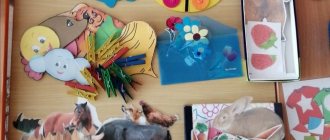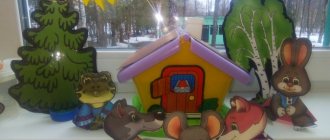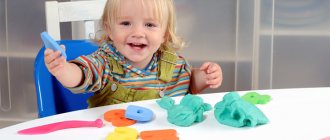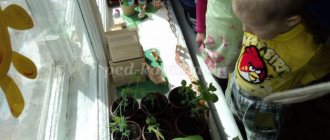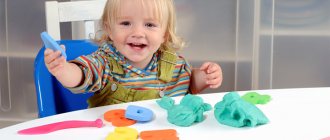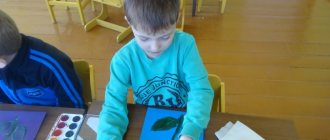Methodological piggy bank for projects
So, dear friends, let's get acquainted with the literature before moving on to a variety of topics.
Together we will look through the pages on the website www.kniga.ru and find a lot of interesting things for our project. An interesting methodological program awaits you. Books, games, projects for preschoolers can be found here.
Another no less interesting site is www.uchmag.ru, where you will find the organization of project activities for children, which is the main requirement for the Federal State Educational Standard. It ensures interaction between parents and teachers in raising children. The program can be installed via the Internet.
On the most interesting website UchMag from the series “To help preschool teachers” you can purchase project notes and organization of design for preschoolers.
Didactic, plot-based, outdoor games are aimed at the personal formation of the child and the development of his creative, mental and social processes. By visiting the methodological site, you, teachers, educators and parents will find comprehensive thematic projects that present entertaining and interesting games with sayings, riddles, stories and poems.
Game projects
Topics on hygiene skills in children
We got acquainted with the literature, now I propose to consider interesting topics. The preschool organization is characterized by interesting and research work in the profession of educators and teachers.
Dear educators and parents, you, of course, want your kids to grow up neat, smart, kind, sympathetic, and you also want to develop cultural and hygienic skills in your kids, don’t you? First, I will propose two projects: the theme of little tidies and the theme of clean hands. The implementation time for the first gaming project is 2-3 weeks, and the second educational, gaming and short-term project is 1 week. Their tasks are:
* proper use of soap;
* careful washing of hands and face;
* wiping dry with a towel after washing;
* use of a comb and handkerchief;
* learning to follow appearance;
* formation of basic table behavior skills: correct use of a spoon, use of a napkin, chewing food with a closed mouth, silence at the table.
First explain all this to the children when playing with dolls: teach them to wipe their mouths, wash the doll’s face and hands, and take care of its clothes. As a result of this project, children themselves will learn to eat carefully, hold a spoon and use a napkin correctly.
This project will also help them dry their face, hands with their towel and then hang it in their place. Children will begin to use handkerchiefs correctly. Personal hygiene will become a natural thing for them. Or you can go on a sea voyage and learn a lot of interesting things.
Bright holiday Easter
The relevance of impressions received in childhood will remain in the memory for a long time. Therefore, it is necessary to introduce children to the history of our Motherland, its culture and its holidays from early childhood. Therefore, the project for the bright holiday of Easter will be a great theme for kids. The purpose of this project is to familiarize children with the Easter holiday, with rituals, customs and its history. It is an informational and creative short-term project and lasts 2 weeks. At the first preparatory stage, the following are compiled:
- long-term action plan;
- recommendations for introducing children to Orthodox culture;
- materials for classes, conversations, illustrations;
- questions with parents related to the topic.
At the second stage, practical classes are conducted:
- with cognitive development: computer presentations “Ryaba Hen”, “Easter Kolobok”;
- with didactic games;
- fiction: Easter stories, conversations;
- artistic creativity: modeling, drawing;
- music with bells, Easter music from a box.
At the third and final stage, exhibitions of interesting crafts by children and parents are organized, as well as participation in a district competition on this topic, as well as work with parents and children’s creativity with them, for example, making Easter eggs.
Project "Poteshki"
The formation and development of children’s speech plays an important role in the child’s personal formation. Nursery rhymes play an important role in the development of children. By listening to simple rhymes, repeated words, exclamations and emotional appeals, children learn to listen and repeat words.
Sound combinations that are repeated create a musical effect with the help of which the pronunciation of sounds and speech hearing of babies develops. Therefore, the Nursery rhymes project will be very useful for young children. It is long-term (1st junior – 2nd junior group)/
The goals of this project are:
- creating positive emotions;
- development of children's speech skills, as well as imagination, thinking and memory.
The objectives are:
- teaching children to listen to short nursery rhymes;
- repetition of words and phrases after the teacher;
- development of monologue and dialogue in children;
- development of fine motor skills in children;
- education of speech culture of sound.
Methods and techniques for implementation are:
- reading nursery rhymes with demonstration of paintings;
- conversations on the meaning of nursery rhymes;
- playing out the plot of nursery rhymes.
As a result, with the targeted and systematic use of nursery rhymes, children master their native language, modeling, drawing, physical and musical development, as well as initial hygiene and self-care skills.
Environmental education of children
Equally important is the upbringing of children related to the protection of the environment. Currently, a loving and caring attitude towards nature is very important for every person. Therefore, it is necessary to introduce children to it from a young age. I hope you agree with me, dear readers.
Therefore, for better implementation of the tasks of environmental activities, project activities on this topic are carried out.
So, let’s start working with the children on the topic: “Let’s feed the birds.” An interesting topic that will foster a caring attitude towards living nature. This is an informational and creative game short-term project for two weeks. The objectives of this project are:
- introducing children to birds;
- learning to answer questions in a short sentence;
- enriching vocabulary on the topic;
- fostering a caring attitude towards birds.
The project can be implemented using:
- jointly writing a story about feeding the birds;
- outdoor game: “Car and sparrows”;
- bird watching;
- memorizing a poem about a bird;
- unconventional drawing technique;
- didactic games, for example “Who lives in the house”;
- working with parents: making feeders.
As a result, children will become acquainted with birds, distinguish them, and learn to imitate bird voices. Children will develop compassion, responsiveness, and goodwill.
You can also introduce children to the project “Objects of Inanimate Nature” and develop children’s knowledge about the physical properties of the external environment, introduce them to viscosity, flowability, buoyancy, solubility of substances, as well as the sun, air, earth, water as environmental factors. This project will last two weeks.
Project in the first junior group “Magic Water”.
Transcript
1 Municipal budgetary preschool educational institution “Kindergarten 1 combined type” town. Zheshart Project in the first junior group “Magic Water”. Compiled by: Kuptsova Irina Anatolyevna
2 She is both in the lake and in the puddle She is circling above us like a snowflake, She is also boiling in our kettle. It even gurgles in our little river.
3 Project passport Project participants: children of the first junior group, teachers, music director, parents. The type of project is educational and research. Duration: medium term. Implementation time 2 weeks.
4 OBJECTIVE: Introduction to the properties of water; Formation of skills of experimenting with objects; Development of fine motor skills; Enrichment of vocabulary.
5 Relevance. Educational activities and games with water for a child open the door to the world of the unknown; water is an amazing object of knowledge. The first substance that a baby gets acquainted with with pleasure is water; it gives the child a pleasant feeling, develops various receptors and provides almost unlimited opportunities to explore the world and himself in it. This is especially important for the youngest children. Water is of particular interest to children. Water is very convenient for search and research activities. Water has psychotherapeutic properties: relieves stress and promotes relaxation. And there is water always and everywhere.
6 Educational objectives Artistic aesthetic development: Develop the initial skills of children's creativity. To instill in children an aesthetic taste for everything beautiful that surrounds us. Develop an interest in music. areas: Develop children's activity when singing along and singing. Encourage them to perform simple dance movements. Create a need for reading. Provide children with the opportunity to finish words and phrases when reading familiar poems and nursery rhymes.
7 Cognitive development: Stimulate interest in playing with water. Develop basic research skills. Social communicative development: Develop the desire to communicate with peers during gaming activities; Develop the ability to communicate with adults and answer questions. Speech development: Develop the ability to answer simple questions and conduct a dialogue with an adult. Physical development: Maintain and strengthen children's health. Develop physical activity and fine motor skills of the fingers.
8 Stage I Stages of project implementation: Select methodological and fiction literature on the topic; Choose illustrations depicting water, snow, rain, sea. Design a subject-specific development environment. Selection of material for practical games and activities. Introducing parents to the objectives of the “Magic Water” project.
9 Subject development environment
10 Stage II: Organization, carrying out various types of activities:
11 Artistic aesthetic development: Non-traditional drawing technique: “Octopus palms” - drawing with a palm, “Rain, rain, drip, drip, drip” - finger painting, Application “Fish swim in the water”; Modeling “White fluffy snowflakes” - plasticineography. Listening to the sounds “The Sound of a Stream”, Listening to the musical piece “Rain” by G. Lobacheva, singing the song “Rain, Rain, More Fun”, dancing the game “Rain”.
12 Artistic aesthetic development: Reading p. N. s. "Snow Maiden". K.I. Chukovsky “Moidodyr”, A. Barto “Dirty Girl”;, B. Zakhoder “Rain”. Nursery rhymes: “Water, water”, “Open the faucet”, “The bunny began to wash himself”, “Oh, okay, okay, okay, we’re not afraid of water”, “The geese and swans were flying”, “Oh, the water is good”, “We’ll go for a swim” .
13 Octopuses, Octopuses It has eight legs
14 Snowflakes and golden pieces of ice are falling. They fall, spin, and lie on the ground.
15 There were clouds in the sky, But we took an umbrella with us. The cloud and the sun started playing hide and seek again. As soon as the sun hides, Cloud will burst into tears.
16 Cognitive development: Observing natural phenomena while walking; Conversation “What is water for? Observing fish in an aquarium. Experiments with water: “Water is liquid, it flows”, “Water is transparent”, “Sinking does not sink”, “Hot, warm, cold water”, “Ice is solid water”, “Colored water”, “Ice is lighter than water”, "Transformation into water."
17
18 . Water can be colored with gouache Water. turns to ice. Colored ice floes.
19 Our Tanya is crying loudly, She dropped a ball into the river. Hush, Tanya, don’t cry, The ball won’t drown in the river. Heavy objects sink in the water, stones drown.
20 Social and communicative development: Games for fun with water: “Hello, water”, “Fishing”, games with rubber toys, the game “Take the little frog for a ride in a boat”, “What floats”. "Bathing a doll." “We do the laundry, we help mom,” games with soap bubbles: “Whose bubble is bigger,” “Catch the bubble in your palm.” Finger games: “Here are bare feet running right along the path.”, “The fish are playing merrily.” Didactic games: “Snowflakes droplets”, “And the flowers are thirsty”
21 Exercise “Hello, water.” Invite the children to touch the water with one and the other palm. Stroke the water, touch the water with each finger, “Hello, water.”
22
23 I will wash Little Nastya’s hands, back and tummy, face and mouth. Games “Bathing the doll”, “Wash the doll’s clothes”. We wash, we wash We help our mother.
24
25
26 Games with soap bubbles. Blowing bubbles on your own. Game “Catch the bubble in your palm”, Whose bubble is bigger?”
27 Game “Take the frog for a ride on a boat”
28 Speech development: Speech games “In a clearing, on a meadow, a snowball is quietly falling,” “Rain, rain.” Conversation with children “Who loves water”, “Safety rules when playing with water.” Game "Captains" (blow on the boat, pulling your lips with a straw). Conversation on the topic: “Experiments with water.”
29
30 Physical development Physical minutes: “Rain, pour down”, “Swifts are flying over the water”, “Ice house”, “Let’s throw a fishing rod into the water”. Finger games: “Fish”, “Here are the bare feet running.” Game exercise “Wander through the puddles.”
31 Finger exercise in water: Fishes play happily in warm sunny water. They'll clench and unclench, and then they'll bury themselves in the sand. Offer to show how your fingers run through the water. Here are bare feet running, right along the path.
32. Don’t be sorry for the rain, you give us flowers. Water harder, More often, more fun!
33 Working with parents: Introducing parents to the objectives of the project. Consultation “Experiments with water at home”, “Games with water are interesting”. Making the “Aquarium” model by parents. Involving parents in replenishing the developmental environment with aids (floating toys, wind-up toys, fiction).
34 Layout "Aquarium"
35 Stage III Final Product of project activity: Exhibition of drawings “Magic Water”. Creation of an “Aquarium” layout by parents. Making a collage by parents together with children “Winter-winter”. Final event: entertainment for parents “Winter Walk”.
36
37
38
39 Everyone needs water: And the fish, and the birds, And the trees in the forest, And the flowers in the meadow. And kittens and tiger cubs, even little guys. Water helps us everywhere and always!
40 Thank you for your attention!
Other events
There are also other informational and creative game projects, such as “Cat”, the purpose of which is to familiarize yourself with a domestic animal, in this case a cat, with its characteristics, habits, appearance, as well as fostering a caring attitude towards animals.
It will be interesting to show children the game project “Cat House” on video:
Another information and creative project is “Vitamins”. This topic studies the issues of maintaining health in children. Here ideas are given about vitamins, their importance for health, and proper nutrition. This project lasts 3 weeks.
“My Family” is the name of a creative long-term project. Its purpose is to provide an initial introduction to the family. The objectives are to evoke positive emotions about the family, develop expressions of tenderness, joy, and cultivate respect for parents. I suggest watching a video on this topic with your little friends:
Since preschoolers love to explore everything and put it into practice, there is such an educational, research, group event “The Magic Drop”, the purpose of which is to consolidate existing knowledge about water. The objectives are to familiarize children with the properties of water, support children’s initiative, ingenuity and encourage friendships during the period of research. The project lasts 2 weeks. It's short-term.
Also interesting is the event, the work plan for the master class, which offers creative tasks for parents, organizing competitions, participating in project activities, aimed at developing the children’s abilities and promoting trusting relationships between the family and the kindergarten.
So, to summarize, I come to the conclusion that interesting topics in kindergartens will help develop the intellectual and physical development of children. Therefore, together, dear teachers, educators, and parents, let us make every effort to ensure that our children grow up healthy.
I hope that with this article I helped you make action plans in kindergartens and other preschool institutions. I say goodbye to you, but not for long. Stay tuned for other interesting and informative articles. And if you have questions, be sure to ask. I will be happy to answer them. Share this article with your friends, and by subscribing to my blog updates, you will learn a lot of interesting things.
Sincerely, Tatyana Sukhikh! Till tomorrow!
By the way, I recommend reading:
Child development game for nursery group project
Irina Saushkina
Project for the nursery group “Hello, fairy tale!”
A fairy tale is a beautiful creation of art. A child enters the world of fairy tales at a very early age, as soon as he begins to speak. There is a fairy tale in every home and is very popular among children. Children gain a lot of knowledge from fairy tales. Thanks to fairy tales, children develop the ability to empathize, have compassion and be happy for another; this is the only way to know the pain, joy, happiness and suffering of another person. And it is fairy tales that instill humanity in a child - a wonderful ability to sympathize with the misfortunes of others. The most amazing events, extraordinary transformations are common in fairy tales. Young children's perception of the world around them is varied. Children treat inanimate objects the same as animate ones, and vice versa, treat animate objects as if they were inanimate. In this special world, a child easily and simply masters the connections between phenomena and acquires a large stock of knowledge. A fairy tale for a child is a small life full of bright colors, miracles and adventures. Often a fairy tale contains songs and jokes, and children remember them first.
Today, fairy tales play a vital role in the development of a child’s imagination and instill a love for books in children. In our garden, many activities begin with entering a group of fairy-tale characters. Children play with them with pleasure, receiving a positive emotional mood, they learn the program better. Project “Hello, fairy tale!” We chose it because this topic is closest to our kids. Since many children do not have sufficient vocabulary and speak poorly, in the project we tried, with the help of fairy-tale characters, to activate speech and expand children’s knowledge about the world around them. The project is a daily change of fairy tale during the week. During the week we visited such fairy tales as: “Ryaba the Hen”, “Turnip”, “Masha and the Bear”, “Zayushkina’s Hut”, “Kolobok”.
Project goal: To create conditions for the development of cognitive abilities and speech development of children in the process of implementing the project “Hello, fairy tale!”
Tasks:
1. Create the necessary conditions for introducing children to Russian folk tales. 2. Contribute to the creation of an emotionally positive climate in the group.
3. Invite children to participate in games and entertainment as much as possible, imitating adults. 4. Strengthen children's interest in Russian folk tales. 5. Encourage children to make verbal statements.
6. Create conditions for parental participation in the educational process of preschool educational institutions.
Project passport
Type of project: creative - gaming.
Duration: short term.
Implementation period: from 9 to 13 February 2015
Participants: pupils of the early age group, parents, teachers of children of the “Squirrel” group.
Age of children: 1.6 - 2 years.
Format: group.
Preparatory stage:
— Selection of methodological literature. — Preparation of materials for joint activities with children (colored paper, cardboard, glue, pencils, plasticine.) — Specially selected fairy tales for children of primary preschool age — Selection of audio recordings, illustrations for fairy tales. Expected result:
— Expansion and enrichment of children’s knowledge about the heroes of fairy tales — Development of children’s speech, enriching it with new words and expressions — Development of children’s creative abilities. — Activating the position of parents as participants in the pedagogical process of kindergarten.
Project activity product:
— Joint activity of the teacher and children: modeling “Plates for a Bear”, “Golden Eggs”, drawing “Path for a Kolobok”, applique “The turnip has grown big and big”, collective applique “Zayushkina’s hut”
Project presentation:
— Conducting entertainment “Meadow of Fairy Tales” — Exhibition of works by parents on the topic: “Cover of a favorite fairy tale”
Project implementation
Formation of a holistic picture of the world
Looking at pictures from the series “Wild Animals” Purpose: to practice recognizing and naming forest animals.
Watching the cartoon “Masha and the Bear” Purpose: to evoke a joyful mood, develop speech and vocabulary.
Conversation about the life of forest animals. Goal: to tell about the habits of a fox and a hare (the fox is a predator - it hunts the bunny, he hides from her.)
Game-activity: Fairy tale “Ryaba Hen”
Goals: to encourage children to listen to the fairy tale in a dramatized version and in a regular retelling, to make them want to listen to it again. To develop the ability to generalize by exercising children in selecting corresponding nouns to verbs.
Fiction
Reading the poem by V. Berestov “Bear, bear, couch potato” Purpose: to introduce children to the poem by reading the text to them and looking at illustrations to the text, to attract children to repeat individual words and phrases from the text of the work; develop attention and memory; cultivate interest in fiction
Reading the fairy tale “Kolobok” with a display on a flannelgraph. Goal: To develop the ability to understand simple plots of small fairy tales, to encourage repetition of the kolobok song.
Repetition of the nursery rhyme “Cockerel-cockerel” Purpose: to practice pronouncing a familiar nursery rhyme.
Puppet theater show based on the fairy tale “The Three Bears” Purpose: To teach them to listen and understand a fairy tale that is accessible in content, to create a joyful mood in children when showing a theatrical fairy tale.
